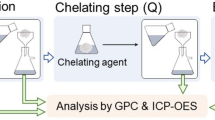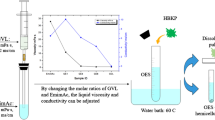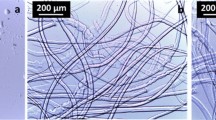Abstract
Knowledge about how different metal ions are bound to pulp fibers is very important for optimal metal management in pulping processes. A column chromatographic method was used to assess the differences in affinity of 14 metal ions to untreated, alkali-treated and peroxide-bleached thermomechanical pulp (TMP). A method of competition between cations in the column chromatographic experiments was used in the sorption experiments, with an excess of each metal ion compared to the total capacity of the pulp studied. The method is very sensitive and even small differences in affinities can be detected. By combining the results from sorption experiments with four different metal ion mixtures the following order of affinity was obtained: Pb2+ ≫ Cu2+ ≫ Cd2+ > Zn2+ > Ni2+ > Ba2+ > Ca2+ > Mn2+ > Sr2+ > Mg2+ ≫ Rb+ ≈ K+ > Na+ > Li+. All three types of pulps showed the same affinity order. Lead and copper ions were clearly most strongly bound to the pulp fibers. Within the alkali and alkaline earth metal groups the differences in affinity were quite small. The sorption of metal ions to pulp fibers takes place mainly by complexation, where the divalent metal ions are coordinated to functional groups (acid groups) in the fiber phase. Protonation constants and concentrations of acid groups were determined by potentiometric titration. A model with two carboxyl groups and two phenolic hydroxyl groups satisfied best the experimental data. By treatment with alkali and peroxide new acid groups were created and the total binding capacity of hydrogen ions increased from 137 μeq/g for untreated pulp to 187 and 228 μeq/g for alkali-treated and peroxide-treated pulp, respectively.






Similar content being viewed by others
References
Burton JT (1986) An investigation into the roles of sodium silicate and Epsom salt in hydrogen peroxide bleaching. J Pulp Pap Sci 12:95–99
Colodette JL, Dence CW (1989) Factors affecting hydrogen peroxide stability in the brightening of mechanical and chemimechanical pulps. Part IV: the effect of transition metals in Norway spruce TMP on hydrogen peroxide stability. J Pulp Pap Sci 15:79–83
Colodette JL, Rothenberg S, Dence CW (1988) Factors affecting hydrogen peroxide stability in the brightening of mechanical and chemimechanical pulps. Part 1: hydrogen peroxide stability in the absence of stabilizing systems. J Pulp Pap Sci 14:126–132
Colodette JL, Rothenberg S, Dence CW (1989) Factors affecting hydrogen peroxide stability in the brightening of mechanical and chemimechanical pulps. Part III: hydrogen peroxide stability in the presence of magnesium and combination of stabilizers. J Pulp Pap Sci 15:45–50
Dronnet VM, Renard CMGC, Axelos MAV, Thibault JF (1997) Binding of divalent metal cations by sugar-beet pulp. Carbohydr Polym 34:73–82
Fardim P, Holmbom B (2005) Origin and surface distribution of anionic groups in different papermaking fibres. Colloids Surf 252:237–242
Fardim P, Holmbom B, Ivaska A, Karhu J, Mortha G, Laine J (2002) Critical comparison and validation of methods for determination of anionic groups in pulp fibres. Nord Pulp Pap Res J 17:346–351
Forsskåhl I (2000) Brightness reversion. In: Stenius P (ed) Forest products chemistry, papermaking science and technology, book 3. Fapet Oy, Helsinki, pp 279–332
Gran G (1952) Determination of the equivalence point in potentiometric titrations. Part II. Analyst 920:661–671
Granholm K, Su P, Harju L, Ivaska A (2009) Study on desorption of Mn, Fe and Mg from TMP and evaluation of the complexing strength of different chelating agents using side reaction coefficients. Holzforschung 63:785–790
Granholm K, Harju L, Ivaska A (2010a) Desorption of metal ions from kraft pulps. Part 1. Chelation of hardwood and softwood kraft pulp with EDTA. Bioresources 5:106–116
Granholm K, Harju L, Ivaska A (2010b) Desorption of metal ions from kraft pulps. Part 2. Chelation of kraft pulps with different complexing agents and with EDTA in a reducing environment. Bioresources 5:227–243
Guo X, Zhang S, Shan X (2008) Adsorption of metal ion on lignin. J Hazard Mater 151:134–142
Gupta VN (1970) Effect of metal ions on brightness, bleachability and colour reversion of groundwood. Pulp Pap Can 71:69–77
Harris DC (1995) Quantitative chemical analysis, 4th edn. W.H. Free, New York, pp 786–787
Herbelin A, Westall JC (1999) FITEQL: a computer program for determination of chemical equilibrium constants from experimental data [computer program], v. 4.0. Department of Chemistry, Oregon State University, Corvallis
Holmbom B, Pranovich AV, Sundberg A, Buchert J (2000) Charged groups in wood and mechanical pulps. In: Kennedy JF, Philps GO, Williams PA, Lönnberg B (eds) Cellulosic pulps, fibers and materials. Woodhead, UK, pp 108–119
Holmbom B, Konn J, Pranovich AV (2005) What is the true yield of TMP and CTMP? What is lost in refining and bleaching? In: Proceeding of the international mechanical pulping conference, Oslo, Norway, June 7–10, pp 98–101
Ingman F, Still E (1966) Graphic method for the determination of titration end point. Talanta 13:1431–1442
Ivaska A, Harju L (2000) Analysis of inorganic constituents. In: Sjöström E, Alén R (eds) Analytical methods in wood chemistry, pulping and papermaking. Springer, Berlin, pp 287–304
Ivaska A, Wänninen E (1973) Potentiometric titration of weak acids. Anal Lett 6:961–967
Karhu JT, Snickars PM, Harju LU, Ivaska AU (2002) Cation exchange of alkali and alkaline earth metal ions on hardwood kraft pulp. Appita J 55:392–397
Lapierre L, Bouchard J, Berry RM, Van Lierop B (1995) Chelation prior to hydrogen peroxide bleaching of kraft pulps: an overview. J Pulp Pap Sci 218:268–273
Pranovich AV, Sundberg KE, Holmbom BR (2003) Chemical changes in thermomechanical pulp at alkaline conditions. J Wood Chem Technol 23:89–112
Pranovich A, Reunanen M, Sjöholm R, Holmbom B (2005) Dissolved lignin and other aromatic substances in thermomechanical pulp waters. J Wood Chem Technol 25:109–132
Ringbom A (1963) Complexation in analytical chemistry. Wiley, New York
Rudie AW, Ball A, Patel N (2006) Ion exchange of H+, Na+, Mg2+, Mn2+ and Ba2+ on wood pulp. J Wood Chem Technol 26:259–272
Saarela K-E (2009) Element analysis of wood materials by external millibeam thick target PIXE. Thesis for doctoral degree, Åbo Akademi University, Åbo, Finland
Saarela K-E, Harju L, Lill J-O, Heselius S-J, Rajander J, Lindroos A (2005) Quantitative elemental analysis of dry-ashed bark and wood samples of birch, spruce and pine from south-western Finland using PIXE. Acta Acad Abo Ser B 65:1–27
Sjöström E (1989) The origin of charge on cellulosic fibers. Nord Pulp Pap Res J 4:90–93
Södö M, Su P, Granholm K, Harju L, Ivaska I (2007) Study on metal ion affinities to oxygen delignified hardwood kraft pulp by a column chromatographic method. Nord Pulp Pap Res J 22:462–467
Su P, Granholm K, Harju L, Ivaska A (2008) Use of column chromatography for the study of metal ion binding to oxygen bleached softwood pulp. In: Proceedings of 2nd international papermaking and environment conference, Tianjin, China, pp 242–245
Su P, Granholm K, Harju L, Ivaska A (2010) Study of metal ion binding to unbleached softwood kraft pulp by column chromatography. Appita J 67:143–149
Sundberg A, Pranovich A, Holmbom B (2000) Distribution of anionic groups in TMP suspensions. J Wood Chem Technol 20:71–92
Sundman O, Persson P, Öhman LO (2008) A multitechnique study of the interactions between H+, Na+, Ca2+, Cu2+ and two type of softwood kraft fiber materials. J Colloid Interface Sci 328:248–256
Towers M, Scallan AM (1996) Predicting the ion-exchange of kraft pulps using Donnan theory. J Pulp Pap Sci 22:332–337
Wuorimaa A, Jokela R, Aksela R (2006) Recent developments in the stabilization of hydrogen peroxide bleaching of pulps: an overview. Nord Pulp Pap Res J 21:435–443
Acknowledgments
This work is a part of the activities at Åbo Akademi Process Chemistry Centre within the Finnish Center of Excellence Program (2000–2011) by the Academy of Finland. Financial support from the Research Institute of Åbo Akademi Foundation is also gratefully acknowledged.
Author information
Authors and Affiliations
Corresponding author
Rights and permissions
About this article
Cite this article
Su, P., Granholm, K., Pranovich, A. et al. Sorption of metal ions to untreated, alkali-treated and peroxide-bleached TMP. Cellulose 17, 1033–1044 (2010). https://doi.org/10.1007/s10570-010-9439-1
Received:
Accepted:
Published:
Issue Date:
DOI: https://doi.org/10.1007/s10570-010-9439-1




